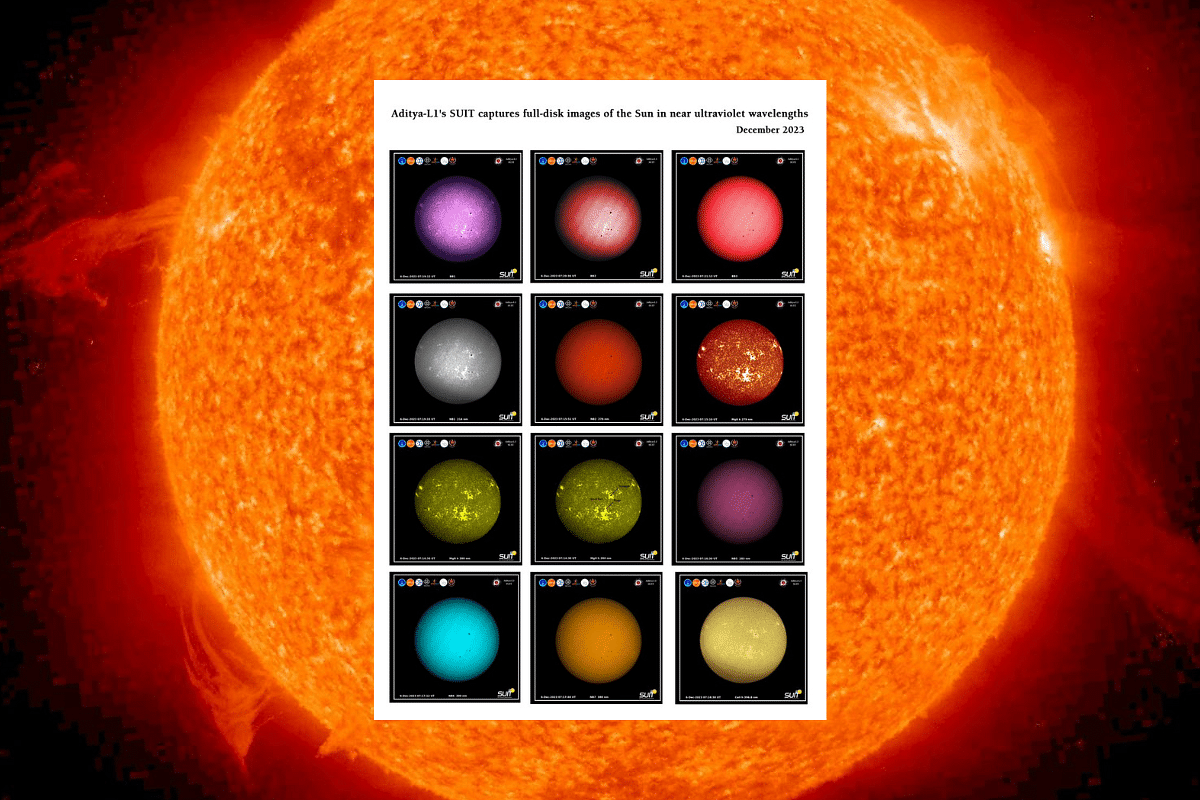Science
Aditya-L1: 'Opening Its Eyes', SUIT Instrument Snaps First-Ever Full-Disk Images Of The Sun In Near-Ultraviolet Wavelengths

The images include the first-ever full-disk representations of the Sun in 200-400 nm wavelengths.
A key instrument on board India's first-ever solar probe, Aditya-L1, has thrown up the first full-disk images of the Sun in the 200-400-nanometre (nm) wavelength range.
Called Solar Ultraviolet Imaging Telescope (SUIT), the payload captures images of the Sun's photosphere and chromosphere in this wavelength range using various scientific filters.
SUIT was developed in a collaborative effort under the leadership of the Inter-University Centre for Astronomy and Astrophysics (IUCAA), Pune.
The instrument was powered on by the Indian Space Research Organisation (ISRO) on 20 November.
After a successful pre-commissioning phase, the telescope captured its first light and took science images on 6 December.
"These unprecedented images... include the first-ever full-disk representations of the Sun in wavelengths ranging from 200 to 400 nm, excluding Ca II h. The full disk images of the Sun in the Ca II h wavelength has been studied from other observatories," ISRO said in a note.
Sunspots, plage, and quiet Sun regions are among the notable features revealed in the imagery, which offers scientists "pioneering insights into the intricate details of the Sun's photosphere and chromosphere."
"Aditya L1's SUIT opens its "eyes"," IUCAA said in an X post.
Professor Durgesh Tripathi, IUCAA professor and principal investigator of the SUIT instrument, said it was a "lifetime opportunity to conceive a space telescope & get to see its first light observations."
"SUIT observations will help scientists study the dynamic coupling of the magnetized solar atmosphere and assist them in placing tight constraints on the effects of solar radiation on Earth's climate," ISRO said.
Studying solar flares is one of the primary goals of SUIT.
The IUCAA-led collaboration to develop SUIT included ISRO, the Manipal Academy of Higher Education (MAHE), the Centre for Excellence in Space Science Indian (CESSI) at IISER-Kolkata, the Indian Institute of Astrophysics (IIA) in Bengaluru, the Udaipur Solar Observatory (USO-PRL), and Tezpur University in Assam.
SUIT was seen alongside the Visible Emission Line Coronagraph (VELC) on board Aditya-L1 in the solar probe's first-ever selfie taken in early September.
Aditya-L1 is equipped with seven scientific instruments in all.
ISRO Chairman S Somanath revealed that they anticipate India's solar probe to reach the orbit around the Lagrange point 1 (L1) by 7 January.
Support Swarajya's 50 Ground Reports Project & Sponsor A Story
Every general election Swarajya does a 50 ground reports project.
Aimed only at serious readers and those who appreciate the nuances of political undercurrents, the project provides a sense of India's electoral landscape. As you know, these reports are produced after considerable investment of travel, time and effort on the ground.
This time too we've kicked off the project in style and have covered over 30 constituencies already. If you're someone who appreciates such work and have enjoyed our coverage please consider sponsoring a ground report for just Rs 2999 to Rs 19,999 - it goes a long way in helping us produce more quality reportage.
You can also back this project by becoming a subscriber for as little as Rs 999 - so do click on this links and choose a plan that suits you and back us.
Click below to contribute.
Latest